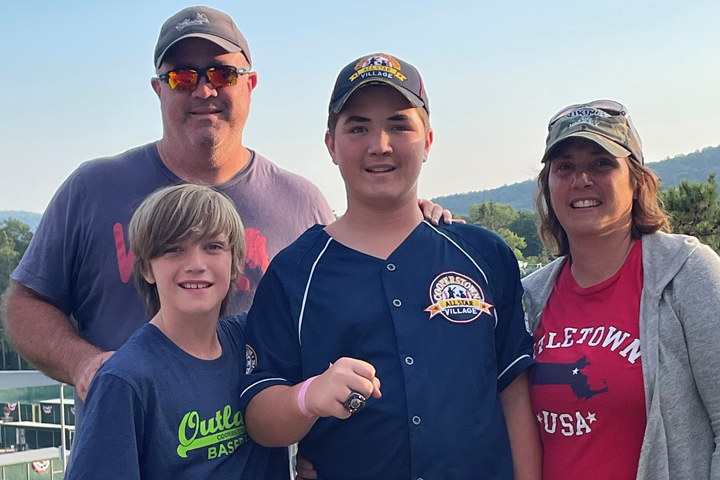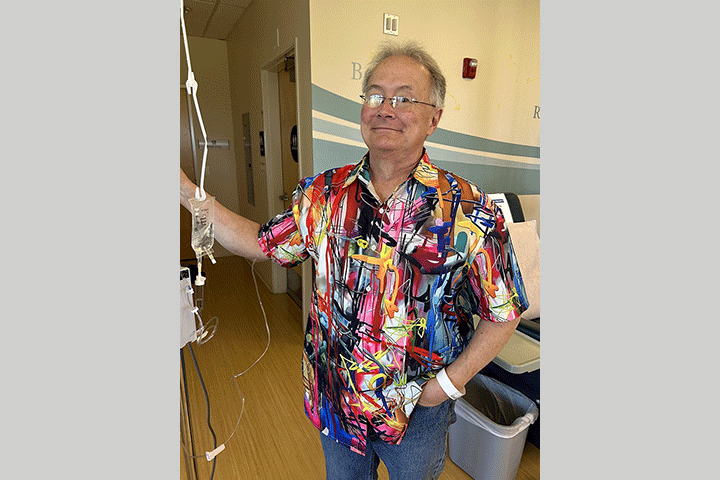A Second Opinion Leads to Hope for the Future

- Traveling for a second opinion, treatment, and side effect management
- Chemotherapy with FOLFIRINOX
- On a chemo break
I was diagnosed with stage IV pancreatic adenocarcinoma in 2018, in the week of my 45th birthday.
At the time of my diagnosis, I was a busy mom and wife, working full-time and taking care of my sons, who were 7 and 9 years old.
The news it was cancer came following several weeks of vague symptoms including acid reflux, a mild cough, stomach discomfort, and minor fatigue. I also began experiencing night sweats, hot flashes, and other changes that were similar to those women experience as a natural part of aging. After developing a persistent fever, my primary care doctor conducted multiple tests that came back negative, including a mono test, which was the final test before I took action.
A nurse friend insisted that I push for additional answers, so on the night before my 45th birthday I visited an emergency room near my home in Rhode Island. After an evening full of tests, I insisted on a CT scan. Within hours, the doctors reported that I had a 2.5-cm cystic lesion on my pancreas and additional lesions on my liver. There was also evidence of lymph nodes reacting to whatever was in my body. With additional tests the lesion on my pancreas was eventually determined to be stage IV pancreatic cancer.
Seeking a Second Opinion
The oncologists at a local Rhode Island hospital reviewed two chemotherapy options: a standard chemotherapy treatment or a second, scaled-back chemotherapy regimen they referred to as a clinical trial. The scaled-back version, the doctors believed, would likely give me a more favorable quality of life than the current standard of care would provide. Armed with the information about my options and the knowledge that I did, in fact, have cancer, I sought out a second opinion. I contacted Dana-Farber Cancer Institute in Boston, Massachusetts, and the team there saw me immediately. I was prescribed FOLFIRINOX and remained as a patient, working with Dr. Nadine McCleary.
Before beginning the chemo regimen I underwent an additional biopsy, genetic and genomic testing, all of which sought to give me personalized information on clinical trials and available treatment options if FOLFIRINOX did not work or if I could not tolerate it.
Life on Chemotherapy
The chemotherapy treatments were intensive, lasting between four and six hours a day every other week, totaling 50 treatments. While receiving treatment I received a number of therapies that helped with side effects (e.g., hydration, white blood cell count and platelet boosters). Additionally, I began adopting significant lifestyle changes while treatments were ongoing, modifying my diet to cut down on or eliminate intake of sugar, flour, and acidic foods and drinks, and working with Dana-Farber nutritionist Hannah Dalpiaz. I also began exploring alternative treatment options, undergoing biweekly acupuncture sessions as well as acupressure sessions with an emphasis on visualization, and imagining positive outcomes with the hope of helping bring them to fruition.
My first follow-up scan after undergoing treatment with FOLFIRINOX revealed encouraging news —the tumor had shrunk by 75 percent. Subsequent scans showed that things remained stable, which wasn’t necessarily bad news, but it wasn’t what I had hoped to hear, either. Over time, the stability turned into additional shrinking.
Throughout the treatment ordeal, there remained a spot on my liver. In December of 2019, scans revealed I no longer had active cancer on my pancreas, but the large spot on my liver was still there. My husband and I asked that my medical team remove the spot and biopsy it. Initially, the tumor board disagreed. My oncologist was persistent and asked the tumor board to review my case again.
In March 2020, at the beginning of the pandemic, I had the spot removed via cryoablation. A subsequent biopsy revealed positive news: The spot was not cancer at all, but likely a cyst I had since birth. This explained why it was the only spot that had not responded to the chemotherapy. After a round of additional scans, the doctor recommended I take a break from the chemotherapy.
A Chemo Break
I have not received treatment for active cancer since June 9, 2020. I visit Dana-Farber for periodic scans every three to four months, and the scans continue to show no active cancer. I remain hopeful for the future.
When talking to others, I stress the importance of seeking a second opinion at a major cancer hospital or academic cancer center. By doing this you are not only getting a second opinion, you are getting treated at a hospital that is seeing and treating more pancreatic cancer patients than a local hospital. It is so important to be able to manage side effects when going through chemotherapy and those hospitals are extremely familiar with doing that. The doctors and nurses at Dana-Farber were very familiar with the side effects I experienced along the way and were able to help manage them, which I believe was an important factor for me to continue with treatment for as long as I did.
Watch Leanne tell her story in “You Can Be the Outlier.”






